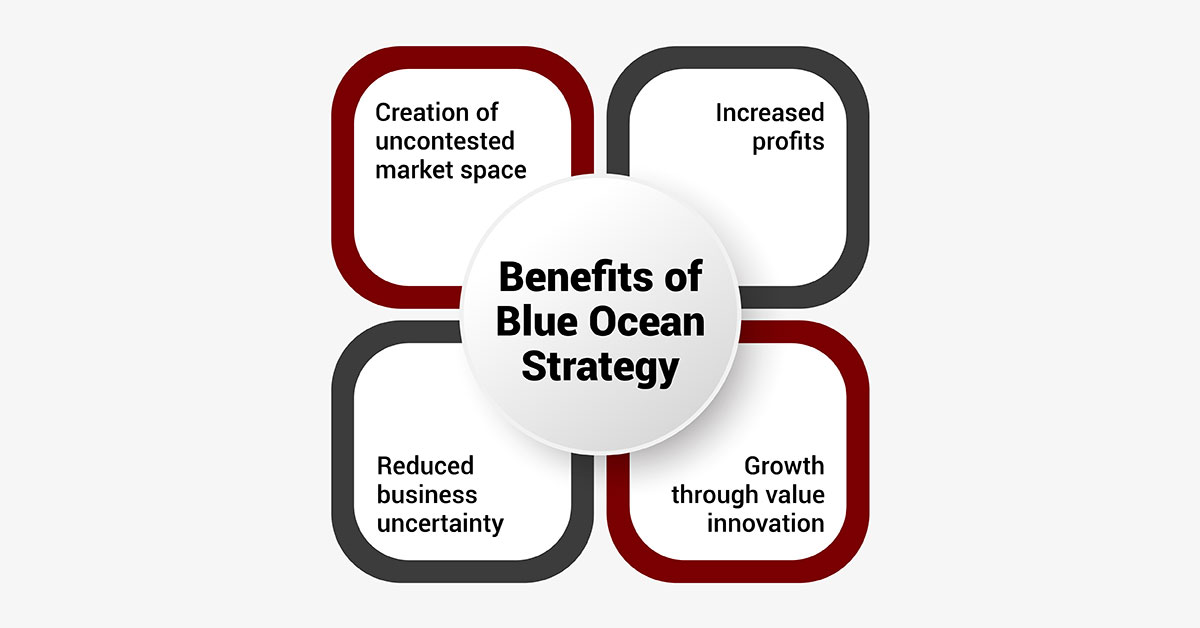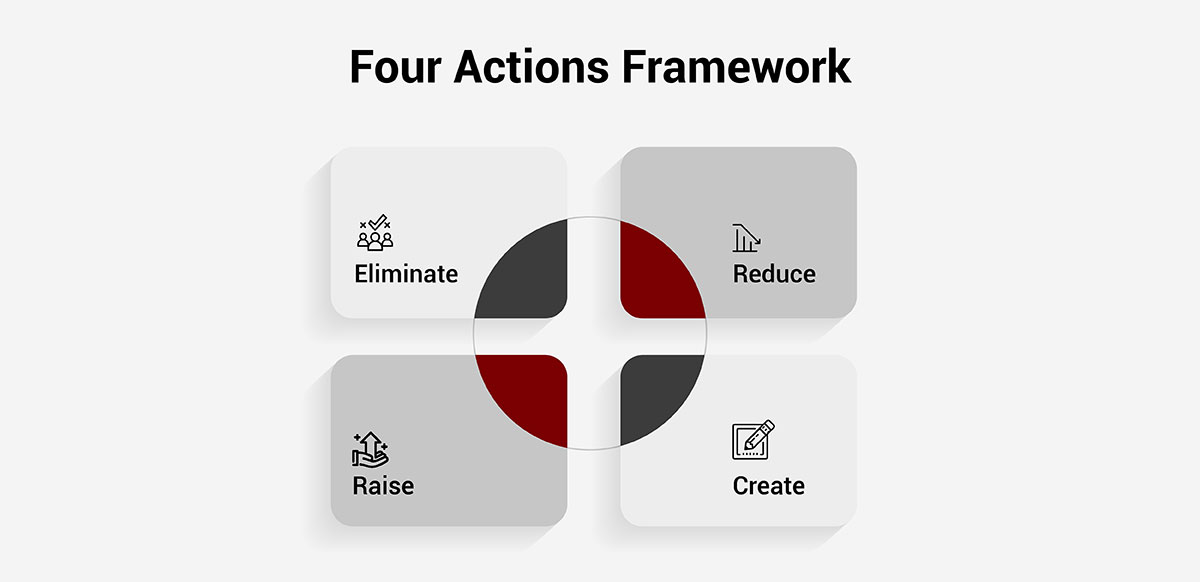Finding Untapped Markets: An Introduction to Blue Ocean Strategy
 November 08, 2024
November 08, 2024
In today's saturated markets, traditional competitive strategies often result in diminishing returns. To sustain profitable growth, businesses need to transcend cutthroat competition and explore new market spaces untouched by rivals. This is where the concept of Blue Ocean strategy comes in.
Coined by Professors W. Chan Kim and Renée Mauborgne, the Blue Ocean strategy aims to make the competition irrelevant by exploring how to create uncontested market space through value innovation. This article discusses the key principles of Blue Ocean strategy and provides a step-by-step guide to applying its strategic frameworks and tools to drive innovative growth for your business.
What is the Blue Ocean Strategy?
Blue ocean strategy is an approach that focuses less on competing within an existing industry and more on creating new markets. Unlike traditional red ocean strategies where companies compete head-to-head for a share of existing demand, Blue Ocean strategy seeks to increase demand. The goal is to make the competition irrelevant by creating a leap in value for buyers as well as for the business, thereby opening up new Blue Oceans of opportunity.
Key pillars of Blue Ocean strategy include:
-
Value innovation: Creation of value for both the buyer and the business through innovation. This involves looking beyond existing product/market boundaries and identifying attributes consumers currently value as well as those they might value in the future.
-
Strategic frameworks: Tools like the 4 Actions Framework and Strategy Canvas help systematically reconstruct market boundaries to transition from red to Blue Oceans.
-
Co-creation: Successfully applying the Blue Ocean business strategy requires input from all stakeholders. This includes customers in the ideation process to better understand unmet needs.
Benefits of Blue Ocean Strategy
There are several advantages of adopting a Blue Ocean strategy instead of battling in crowded red oceans:

-
Creation of uncontested market space
One of the key benefits of pursuing a blue ocean strategy is that it allows companies to create entirely new market spaces where there is no existing competition. When a company is able to identify and meet customer needs in innovative ways that have not been addressed before, it opens up a blue ocean - an uncontested market space where the company is the sole occupant initially.
This presents enormous growth opportunities because the company does not need to steal market share from existing competitors. Instead, it can focus all its efforts on exploring the new market space and attracting new customers who were previously unserved. There are no pre-existing competitors trying to defend their turf either. The lack of competition means the blue ocean pioneer faces less barriers to growth and can scale up more easily by tapping into the massive potential of an untapped market.
-
Reduced business uncertainty
By creating a new market space rather than competing in an already crowded one, blue ocean strategies help reduce business uncertainty for companies. In red ocean markets, there are already well-established competitors fighting intensely for market share. This leads to huge uncertainty as the competition can dynamically change strategies, launch new offerings, form alliances etc to gain an advantage. They may also try to mimic or improve upon new entrants’ products or services, posing a major disruptive threat.
However, in a blue ocean, the pioneering company faces much less uncertainty as it does not have to continuously keep a watch on competitive moves and counter them. Its growth path is also far more stable as there are no competitors trying to steal market share yet. Resources can be fully focused on exploring customer needs and demand rather than on competitive threats. This allows blue ocean businesses to plan better for the long run without disruptions.
-
Increased profits
One of the biggest benefits of occupying a blue ocean is that it allows companies to hugely increase their profits. In crowded red ocean markets, competition is intense and customers have many choices. This forces companies to keep prices low to protect margins. It also limits how much they can raise prices as competitors will quickly match any increase.
However, in a blue ocean market created by the pioneer, there is no competition putting a ceiling on pricing. The blue ocean company can leverage its advantage of being the sole provider of that unique value proposition to price its offerings in a way that yields high margins. At the same time, by pursuing differentiation as well as low costs through value innovation, its cost structure is also optimized for profits. This powerful combination allows blue ocean pioneers to earn abnormally high returns even as they rapidly scale up.
-
Growth through value innovation
Rather than taking a zero-sum approach of dividing up a fixed market size, blue ocean strategy advocates expanding the overall size of the pie. This is done through the key concept of value innovation - creating new demand by offering a set of values that customers previously did not receive. A blue ocean pioneer grows profits not by fighting over competitive positions, but by making the size of the market irrelevant.
By incorporating value innovation and addressing latent or unserved customer needs in a low-cost way, a blue ocean company attracts more and more customers into its market space. This enables sustained exponential growth way beyond what would be possible by just taking share from competitors. As more buyers are created, the pioneer gets to enjoy the rewards of an expanding market with far less effort than it would need to put into competitive battles.
Four Actions Framework
The Four Actions Framework is the core tool of Blue Ocean strategy that systematically reconstructs the boundaries of an existing industry. It involves answering four questions:

-
Eliminate
Which factors should be eliminated that the industry has long taken for granted? This removes the sources of existing competition. By eliminating factors that the industry has long competed on, companies can remove the very sources of competition that are the basis for rivalry.
For example, in the hotel industry, factors such as room size, location, service, and amenities had long been the focus of competition. However, by eliminating room size and many amenities that drove up costs, the hotel chain CitizenM was able to offer affordable accommodation with consistent quality. This eliminated the basis on which the industry had historically competed on for decades. By getting rid of expectations around room size and amenities, CitizenM created a new demand for affordable lodging and made competition around other factors irrelevant. Eliminating factors the industry takes for granted allows companies to break from traditions and reconstruct industry boundaries.
-
Reduce
Which factors should be reduced well below the industry's standards? Lowering non-core attributes drives down costs.
Factors that are reduced below industry standards are those that are considered non-core to the new value proposition. Reducing such factors drives down costs, allowing companies to offer lower prices. For example, when launching the iMac, Apple reduced CPU speed and hard disk space which were industry standards at the time for measuring computer performance.
However, Apple was focused on offering an all-in-one desktop optimized for basic tasks like the internet and productivity. Reducing non-core aspects that were inflating prices allowed Apple to price the iMac at an attractive level and tap into a new demand for affordable computers. Systematically reducing industry standards can lower costs and barriers to entry, enabling the exploration of new markets.
-
Raise
Which factors should be raised well above the industry's standards? Enhancing core benefits through value innovation.
Factors that are raised far above industry standards become central to a new value proposition. This involves enhancing aspects of the product or service that fulfill key customer pains that were previously unmet or underserved. For example, when Cirque Du Soleil entered the entertainment industry, it raised the artistry and physical skill of performers far above traditional circus standards. This reconstructed the industry boundary and made cirque-style performance central to a new demand for aesthetic, emotionally-engaging live shows. Raising selected factors innovates the core customer value, making the new offering meaningfully different from the norm.
-
Create
Which factors could be introduced that the industry has never offered? Developing completely new ways to satisfy buyer needs.
Completely new factors are created that the industry has never offered before. This involves envisioning innovations that fulfill needs in ways the market has never seen. For example, when Netflix entered the media space it created a streaming video model that let people watch films and TV shows on-demand without late fees. This transformed a physical rental industry into digital on-demand viewing.
Netflix met the customer need for convenient entertainment consumption in a way that was unseen. The creation of new factors that satisfy unmet needs in fresh ways has the power to enter blue oceans and construct new industries.
The Strategy Canvas
This visual tool maps out the key strategic moves of competitors on the y-axis and the alternatives on the x-axis. It helps analyze an industry's current value/cost trade-offs and identify 'fair game' moves that can help transition the market to a profitable Blue Ocean. Together, the Four Actions Framework and Strategy Canvas provide a step-by-step process for value innovation.
-
Step 1: Form a Strategic Group
The first step is to assemble a diverse team that can provide different perspectives. This may include functional experts, customers representing different personas, and independent experts.
-
Step 2: Map the Existing Strategy Canvas
Analyze an industry's current strategic factor approach across competing offers. This identifies pain points and opportunities.
-
Step 3: Apply the Four Actions Framework
Brainstorm answers to its four key questions to uncover non-traditional strategic moves. Chart these on a provisional new canvas.
-
Step 4: Test Feasibility and Attractiveness
Test the conceptual Blue Ocean ideas. Refine based on feedback to maximize opportunities and minimize risk.
-
Step 5: Develop a Business Model
Finalize the new strategy by integrating value proposition, supply chain, revenue model, and other elements into a cohesive business model.
-
Step 6: Execute the Strategy
Roll out the plan, continuously innovating, and adapting to changes in the market environment as the Blue Ocean matures. Monitor using OKRs and adjust course as needed.
Real-World Examples of Blue Ocean Strategy
Let's look at some examples of companies that successfully applied Blue Ocean strategy principles:
-
Netflix disrupted the video rental industry by introducing a DVD-by-mail model and changing perceptions of home entertainment.
-
IKEA made quality furniture affordable by modifying production processes and selling flat-packed for self-assembly.
-
Early Apple positioned itself as a lifestyle tech brand focused on design and user experience to redefine the computer industry.
-
Airbnb transformed lodging by opening up people's private homes as an alternative to hotels worldwide.
-
Costco established a membership warehouse club model selling products in bulk at low margins but high volumes.
Mastering Blue Ocean Strategy Takes Practice
While identifying Blue Oceans may sound straightforward, successful execution requires diligence, perseverance, and adapting to changes with a strategy framework. It's an iterative process that benefits from ongoing refinement and course correction. Companies need to continuously innovate and raise the value bar even in mature Blue Oceans to deter imitators.
Monitoring market shifts and having secondary Blue Ocean ideas ready will help organizations sustain growth leadership over time. With systematic application of its strategic frameworks and tools, Blue Ocean strategy equips businesses with a powerful approach for value innovation and profitable expansion into new market spaces.
Conclusion
In conclusion, the Blue Ocean strategy provides a compelling model for driving sustainable, risk-adjusted growth. By applying strategic frameworks like the 4 Actions and Strategy Canvas, organizations can methodically reconstruct industry boundaries to transition to Blue Oceans of opportunity.
While execution requires diligence and ongoing refinement, successfully charting new blue waters through innovative products and services makes a company's competition irrelevant. Mastering Blue Ocean strategy takes practice, but its benefits for top and bottom lines make it a strategic priority worth pursuing.



